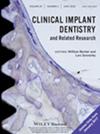Comparison of surface micro-roughness and adaptation of titanium and cobalt chrome implant abutment fabricated by selective laser melting and conventional techniques
Abstract
Purpose
The objective of this study was to assess the surface micro-roughness and abutment adaptation of selective laser melting (SLM) implant abutments in comparison to cast and machined implant abutments.
Methods
Forty abutment specimens were divided equally into four groups according to the fabrication technique as follows (n = 10), Machined Ti alloy abutments (Control), Cast CoCr abutments, SLM-CoCr abutments, and SLM-Ti alloy abutments. Forty internal connection implants (Ø 4.0 ×10 mm, Superline™, Dentium Co., Seoul, Korea) were mounted in clear acrylic resin. Fabricated abutments were assessed for surface micro-roughness using a 3D optical noncontact surface microscope. Vertical and horizontal adaptation of the abutment with implant interface was assessed by using Bruker micro-CT. Data was assessed using analysis of variance and Tukey post hoc comparison tests for all the variables except vertical misfit was assessed using Kruskal–Wallis test. Pearson correlation was used to assess dependence between independent variable (surface roughness) and dependent variables (Horizontal misfit and vertical misfit).
Results
SLM-Ti abutments showed significantly rougher surface (p < 0.05) among the study groups. While SLM-CoCr abutments were smoother than Cast abutments with mean Ra of 1.30 ± 0.11 and 1.58 ± 0.17 μm, respectively (p < 0.05). For abutment adaptation, SLM-Ti abutments showed the highest horizontal misfit among the groups (p < 0.05). While, SLM-CoCr abutments (29.24 ± 11.11 μm) showed comparable (p > 0.05) horizontal misfit results with Cast (26.08 ± 3.93 μm) and machined (26.45 ± 7.33 μm) abutments. Comparable (p > 0.05) vertical misfit values between Cast CoCr (487.01 ± 40.34 μm), SLM-CoCr (358.38 ± 114.93 μm) and SLM-Ti (299.85 ± 172.88 μm) abutments were observed. A positive correlation was found between the surface roughness of the mating surfaces and abutment adaptation.
Conclusion
SLM CoCr abutments exhibited low roughness and comparable abutment adaptation (vertically and horizontally) than cast (control) abutments. Therefore, SLM CoCr abutments should be clinically investigated as potential implant abutments for clinical use.

 求助内容:
求助内容: 应助结果提醒方式:
应助结果提醒方式:


